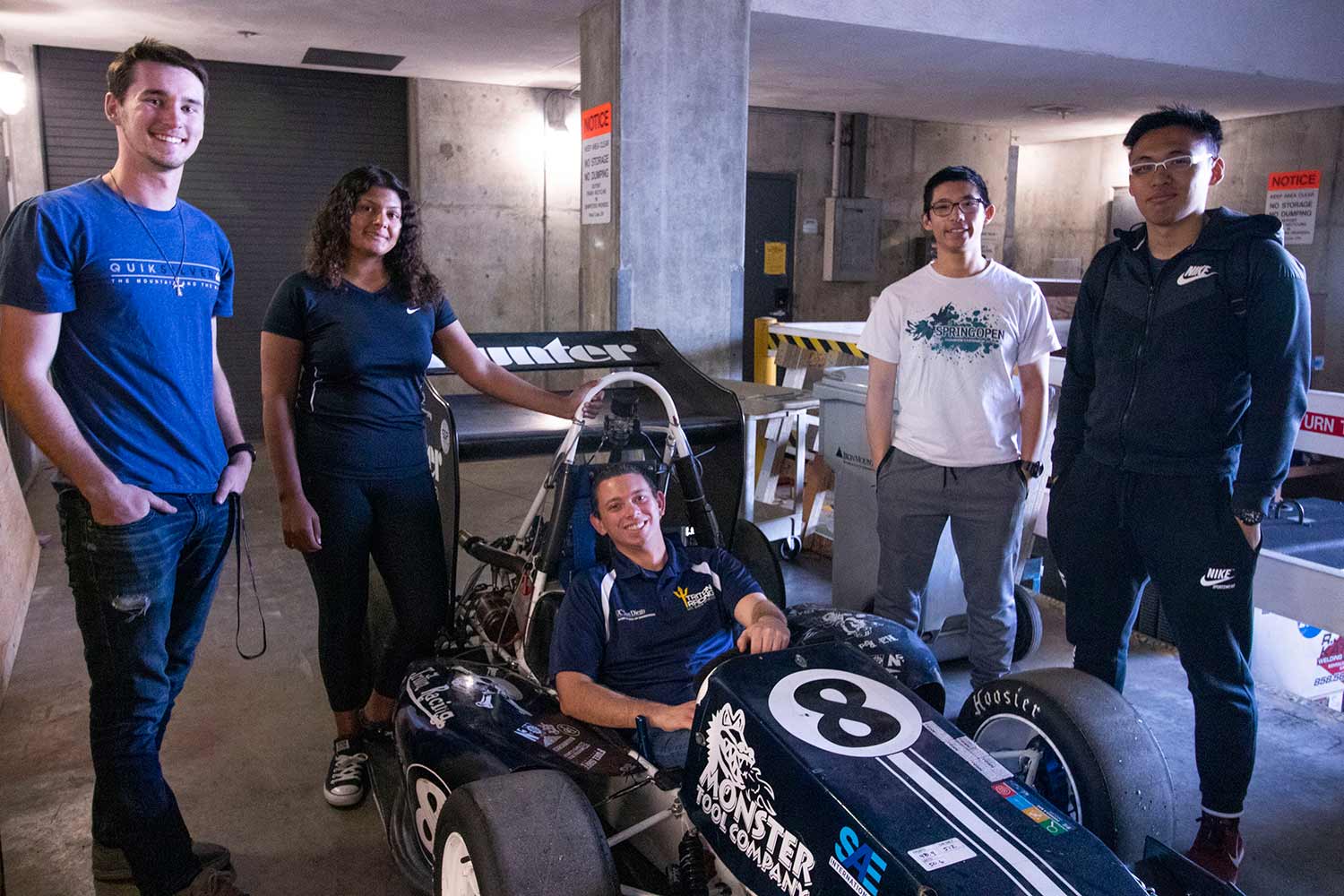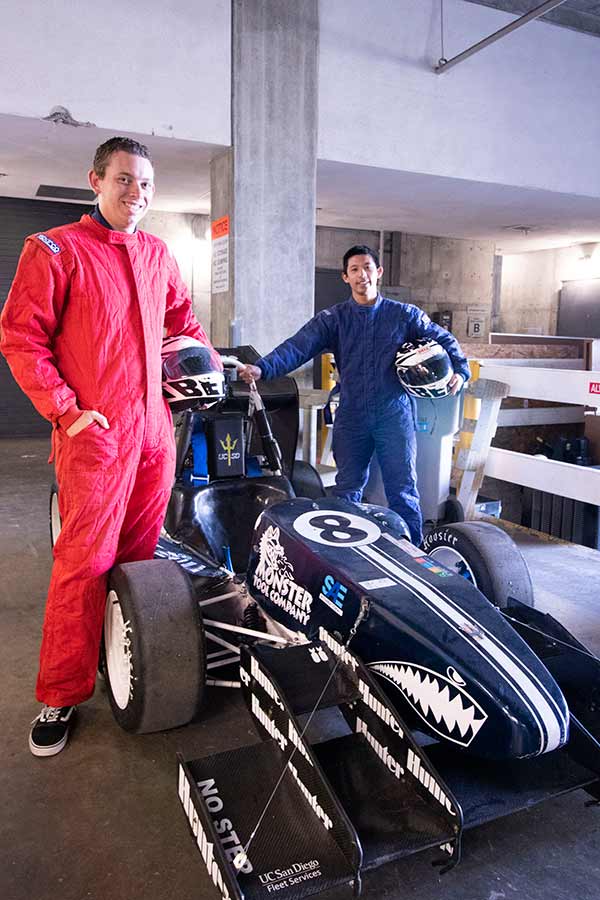By:
- Cynthia Dillon
Published Date
By:
- Cynthia Dillon
Share This:

Members of the Triton Racing Team (left to right): Ryan Kane, Nadia Casper, Edmund Lau and Jack Zheng. Alex Valenze is in the driver’s seat. Photo by Michelle Fredricks, UC San Diego Physical Sciences
Enjoy the Ride
Triton Racing undergraduates gear up for annual competitive car race
When it comes to creating an aerodynamic, race-worthy car that successfully competes in a field of more than 100 teams from around the world, it takes not only a solid racing crew, but also a crew of dedicated scientists and engineers. Luckily, the Triton Racing Program at UC San Diego isn’t short on such crew members.
Allowing undergraduate students to gain hands-on knowledge while applying classroom theory in a real-world setting, Triton Racing includes about 35 members—mostly students from engineering, physical sciences and social sciences—who make up the nonprofit Formula Society of Automotive Engineers (FSAE) Club at the university.
Together, the students push and test their capabilities and innovative talents to establish themselves as leaders in the collegiate field of racing. With the support of its title sponsor Hunter Industries, the club is dedicated to the design, fabrication and testing of an open-wheel race car for the annual FSAE competition, held in Lincoln, Nebraska. This year the race takes place June 19 – 22.
‘On Your Marks’
According to Edmund Lau, a third-year undergraduate physics student, despite their differing majors, all team members share an interest in automotive mechanics.
“It’s the joy of working on the car,” agreed Jack Zheng, a third-year structural engineering student.
Lau explained that based on individual interests, each team member chooses which subgroups to join. Lau, for example, is the team’s public relations director who identifies sponsors and industry partners. He helps out each of the subgroups in order to learn as much as he can about the whole car.
Biophysics undergraduate Alex Valenze, who is vice president of the group on campus and who designed the car’s intake system, is a driver. Next year’s Triton Racing president and nanoengineering undergraduate student Nadia Casper is leading this year’s chassis construction. Ryan Kane, a cognitive science major, is the powertrain sub-lead and rebuilt a modified engine.
Pacing for Racing

Left to right: Edmund Lau, physics and Jack Zheng, engineering work on welding the tailpipe. Photo by Michelle Fredricks, UC San Diego Physical Sciences
The entire car-building project goes through four phases: design, manufacturing, assembly and testing. Lau explained that the team begins designing the new project car in the summer after the competition ends. When fall quarter begins, the team is in full manufacturing mode with members spending long hours in the machine shop located in the basement of Jacobs Hall.
Team members work in shifts, each volunteering an average of 20 hours—some up to 40 hours—each week on the project. The team keeps a few previous years’ race cars parked in the space for reference, looking for ways to improve design and construction. The older cars are also used for driver training.
“Drivers must be team members for at least one year, and we look at their (driving) record,” said Valenze, adding that the team picks five drivers each year.
Once winter quarter hits, Lau said the team starts assembling the vehicle with the goal of having a running car by the end of the quarter.
“Once we have a running vehicle, we start testing it to see how it performs versus our previous vehicles, while also training our competition drivers,” said Lau.
At the Starting Line
The annual competition’s static events begin with hours of technical inspection to ensure rules compliance and safety. This is followed by presentations during which the various teams defend their engineering design decisions and give mock investment proposals to industry and university professionals. Stages of the competition include acceleration tests and skidpad—a circular area used for testing a car’s handling—ending with a one-mile autocross. The second day of dynamic events is dedicated to endurance: a 14-mile-long course where teams race for more than 30 minutes.
“Of the teams that make it to endurance, only 30 percent make it through,” said Lau. “This event truly tests each car’s engineering.”
The team also attends local autocross events and competes in lap times against real sports cars. “We beat most people, but there are a few people with their own custom cars that can beat us,” admitted Lau.
The UC San Diego racers have consistently showed well overall, placing eighth in both the 2017 and 2018 competitions.
Eyes on the ‘Finish Line’

Left to right: Physics undergraduate students Alex Valenze and Edmund Lau are geared up for racing. Photo by Michelle Fredricks, UC San Diego Physical Sciences
“We attend the FSAE Lincoln competition the week right after finals,” said Lau. “There is another competition in Michigan in May, but that competition would be difficult for us logistically since we would all have to take a week off from academics for it, and the timeframe is too close to finals for us to attend.”
Many of the team members have a goal of working in the automotive industry after graduation, so they are not distracted from their studies amidst all the race preparation.
“I personally want to go into the engineering industry, and this team helps gives me a full, coherent engineering experience that would be similar to what I would face in the real world,” explained Lau.
Beyond the fun and the practical experience, Lau said that the overall goal and the people behind that goal make participation most enjoyable.
“All of us, for the most part, enjoy being with each other, and that makes being a part of a team a lot more fun,” he said. “Also, seeing a project on which you have spent countless hours materialize and then competing against other engineering students from around the world is a great experience and feeling to have.”
Valenze agreed. “Designing something yourself and seeing it take shape is very rewarding,” he said.
Lau added that the UC San Diego FSAE Club is operated solely by students with support from sponsorships, the university, grants and alumni companies and industry partners.
Share This:
You May Also Like
Stay in the Know
Keep up with all the latest from UC San Diego. Subscribe to the newsletter today.



